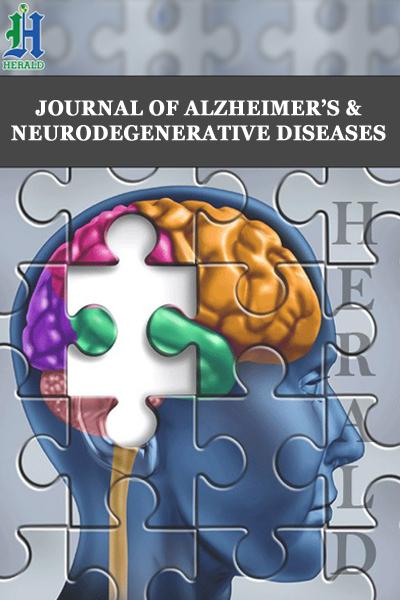
A Report of a Pilot Study Exploring the use of a Mnemonic Strategy for the Recall and use of Functional Language in People with Dementia
*Corresponding Author(s):
Fiona CostaHonorary Research Fellow, School Of Education, University Of Roehampton, Roehampton Lane, London, SW15 5PU, United Kingdom
Tel:07711 417197,
Email:Fiona.Costa@roehampton.ac.uk
Abstract
A later symptom of dementia is a decline in expressive language. Together with memory loss, this can create major communication challenges and high levels of frustration. Research into the use of music as a therapeutic intervention for dementia patients has shown that, even in the late stages of the disease, there remains a capacity to enjoy and respond to music and to learn and recall new music. This sparing of musical ability, together with the fact that language is more readily recalled when sung rather than spoken raises the possibility that a music intervention using a mnemonic strategy may maintain some level of verbal communication in people with dementia.
This was the focus of a six-month pilot study. Once-weekly music sessions were delivered to residents of two care homes specializing in the care of people with dementia. Each session was in two parts. A sing-along that incorporated songs familiar from their teenage years primed musical engagement. This was followed by the introduction of ‘micro-songs’-functional language relevant to daily life set to short specially composed rhythmic melodies. In addition to increased confidence and social interaction, results showed that participants learned the new materials in an average of four weeks and could recall them after intervals of between one week and two-months. Cognitive ability was not a determinant of their capacity to learn and recall the resources. Future research will build on these findings and investigate whether these resources can be embedded in daily life and used to facilitate communication.
Keywords
Music; Dementia; Older people; Mnemonic strategy
BACKGROUND
One of the most distressing symptoms of dementia is the decline of expressive language. Together with memory loss, often an earlier symptom of the disease, this can create a major challenge of communication as well as high levels of frustration. As the disease progresses, the decline in communication ability affects many activities of daily living, particularly social interaction [1-5] and makes it difficult to express choice, for example of food, drink or activity. This challenge of communication is frequently exacerbated by sensory impairments [6] and can result in conflict, isolation, depression and earlier placement in residential care [1]. There is currently no means of preventing this deterioration.
Because there is some evidence for the sparing of certain musical memory functions in dementia, it has been suggested that certain types of music intervention may lead to improved communicational skills [7]. One such intervention is a musical mnemonic strategy, the setting of verbal information to music. A number of studies have investigated the use of this approach to enhance the new learning of information in people with Alzheimer’s disease (AD).
Simmons-Stern et al, Budson and Ally [8] conducted the first study in this field. The ability of people with mild AD to recognize novel texts was tested by comparing the relative effectiveness of spoken and sung recordings (set to an unfamiliar melody). Results showed that the AD group achieved higher scores of text recognition when the words were sung. This finding was not replicated in the healthy control group. These results suggest that the process for the encoding and retrieval of musical stimuli is different in people with AD. However, without any assessment of text recognition or comprehension, the study was limited in its application.
To address this, Simmons-Stern, Deason, Brandler et al. [9] used a similar methodology but assessed memory for both general and specific content. The melodic stimuli were the same as in the previous study, but the texts used were relevant to the daily lives of the participants. As before, the stimuli were presented to two groups, participants with AD and a healthy control group. Results for both groups showed that memory for general content (such as a theme or topic) was significantly better when sung rather than spoken. However, this was not the case for memory of specific content information. The authors suggest, therefore, that with no beneficial effect on memory for specific content a musical mnemonic strategy is not effective for the teaching of novel information to people with AD.
However, these findings are not conclusive. As the authors suggest, alternative methodologies may produce different results. For example, the selection of effective musical stimuli in research is a matter of ongoing debate; different musical stimuli may elicit different results. Variables such as familiarity, valence and structure all need to be considered. The melodies used in these two studies had a simple structure, known to be beneficial to recall, but they were unfamiliar. Earlier research has suggested that learning lyrics is easier when set to a familiar melody [10].
This was the approach adopted in a case study of a patient with mild AD [11]. Four texts were randomly assigned to four conditions: spoken, sung on a non-familiar melody, sung on a recently learned melody and sung on a life-long highly familiar melody. Each of the melodies had a stable, standard meter and was in major mode. Instead of one assessment following one presentation of the stimuli, an extended learning procedure was adopted with ten assessments made over a two-month period. Immediate recall and delayed recall of ten minutes and one month was assessed by the percentage of words successfully recalled.
Initial scores were significantly lower in the unfamiliar song condition, thus suggesting that music’s effect was dependent on some prior knowledge of the melody. Scores for the other three conditions (including the spoken) did not differ significantly from each other. However, the scores increased over the ensuing assessments, thus demonstrating the effectiveness of the extended learning procedure. From week three and thereafter, there was a significant benefit for each sung condition, with the highest scores for the low familiar melody. Delayed recall scores clearly demonstrated the superiority of the sung over the spoken conditions. For example, 21 sung words were recalled compared with nine spoken words. These findings have a number of implications. First, the improvement in scores for the unfamiliar song condition demonstrates a capacity for the learning of new musical material. Second, once the melody and text has been learnt, long-term verbal recall is robust. Third, initial learning difficulty may not be a predictor of the memory outcome.
The same authors carried out a similar study in 2014 [13], this time with a group of participants with mild AD.As before, they assessed immediate recall, delayed recall, melodic familiarity and the effect of repeated learning sessions. The same four conditions were presented. The findings were similar to those of the previous case study in that immediate recall scores showed no advantage of the music conditions. However, scores increased with the extended learning procedure and the sung conditions achieved higher scores, irrespective of melodic familiarity. The authors suggest that the increased memory load that is associated with dual coding limits any advantage of learning lyrics to a familiar melody. Although learning times for sung and spoken text were similar, recall was superior for the sung conditions and suggests that the association of melody and text made the memory trace more robust. The authors suggest that the binding between text and melody could be reinforced if the text was directly related to the everyday needs or activities of the participants.
The approach taken by Palisson et al. [12] was similar, although the methodology differed in four ways: first an additional spoken condition was included-the text was accompanied by a familiar silent film sequence; second, the texts related to everyday life such as holidays or shopping lists as suggested by Moussard et al. [13]; third, although the learning procedure was similar to that of Moussard et al. [13] they did not employ an extended learning procedure only one assessment was made; fourth, delayed recall was assessed at 5 minutes. There were three conditions, each assigned a text: sung on a familiar melody, spoken and spoken with a film. Results showed that for more than 90% of the participants, the sung texts were more effective for both immediate and delayed verbal recall. The authors suggest that these findings can be explained by differences in methodology. These include the use of only sung condition (familiarity may have been effective as there was no extended learning procedure) and the use of a familiar accompaniment which may have been an effective aid.
Although each study discussed above compared music and spoken conditions to assess verbal recall, there are several areas of difference. As already discussed, different musical stimuli can elicit different results. Simmons-Stern et al. [8] presented familiar musical stimuli, Palisson et al. [12] a familiar stimulus and Moussard et al. [11] compared the effectiveness of both. A further difference is in the presentation of the musical stimuli: either a capella [9,11] or with an accompaniment [12]. There is also wide disparity in the content and presentation of the verbal stimulus. As to content, with the exception of [11,12] the texts were irrelevant to the lives of the participants. As to the presentation, in some it was presented visually as well as auditorily [9], in others it was not [12]; in some, the speed was slowed to match the length of the sung version [8,9] in others it was presented at a rate consistent with natural speech [11-13]. A further discrepancy is the number of exposures during the encoding stage. For example, in the studies by Simmons-Stern et al. [8,9] there was one presentation of the stimuli, whereas Moussard et al. [13] and Palisson et al. [12] used a repeated procedure. There are also differences to be observed in the musical backgrounds of the participants. For example Moussard et al. [11,13] recruited non-musicians only whilst Palisson et al. [12] recruited those without a high level of musical training. Each of these variables may have influenced the results.
Some of these methodological differences informed the study carried out by Baird et al. [2]. They assessed the influence of musical training, they used verbal material that was relevant to the participants’ daily lives, with the stimulus being slowed to match that of the sung stimulus; they used a highly familiar musical song (performed a cappella). Immediate and delayed recall (30-minute and 24-hour) was assessed in one session, using a repeated learning procedure. Although the AD musician group had significantly improved scores for the learning of sung information, there were no significant differences found between the sung and spoken conditions in any of the groups. The authors concluded that there was no evidence for mnemonic strategy. Issues of methodology may provide some explanation for the disparate findings. As suggested by the authors, the cognitive load of learning new lyrics to a highly familiar song may have impeded more effective recall. The lack of accompaniment to the sung stimulus may also have been a factor. In addition, their assessment criteria differed from earlier studies. They assessed memory for specific contextual information, a more difficult task than counting the proportion of words correctly retrieved as used by [11,12].
A recent study by Ratovohery et al. [14] used a similar methodology. Their approach was to compare three conditions, two sung to a highly familiar melody and one spoken. A further variable that of valence was added; one melody was high in valence, the other low. Three texts, each related to a different subject of some relevance, were assigned to the three conditions. They conducted a similar learning procedure to that of Palisson et al. [12] and assessment was made of immediate recall scores and of delayed recall scores (10-minute and 24-hour). Results showed that the AD group had higher scores for the sung texts both at encoding and at delayed recall, the only one of these studies to do so. The authors attribute the results to the use of familiar music, to the extended learning procedure and to the visual as well as auditory presentation of the texts. Additional findings demonstrated that, for the AD group, the effect of valence existed at immediate recall but not at delayed recall. The fact that these findings were observed in people with no musical training suggests that this strategy can be applicable to people with AD whatever their musical background.
With the exception of the study by Baird et al. [2], the findings from these studies suggest some effect of a mnemonic strategy for the retrieval of verbal information in people with mild to moderate AD. However, the sample sizes in each of the studies discussed were small: the largest AD group had thirteen participants; the smallest had eight. Although this is unsurprising given the difficulties of carrying out research in this population, it makes it difficult to make strong conclusions or to generalize the findings to a wider population.
Despite the sometimes contradictory and limited findings shown in these studies, the results are of sufficient importance to research this area further. Of particular relevance is the capacity of people with dementia to learn new musical material, the superiority of a music condition to enhance verbal recall and the robustness of the memory trace when the two modalities are combined. These findings provide some basis, as suggested by Ratovohery et al. [14] for the application of a mnemonic strategy for the learning and communicating of practical everyday information. This was the aim of the present study.
METHODOLOGY
The research was carried out over the course of six months. This allowed the research team to investigate the capacity of people with dementia to learn a range of songs and texts and to determine their suitability and effectiveness.
Permission was sought from two care homes, both specializing in dementia care, for the research team to work on a weekly basis with a group of their residents. Over one third (311,730) of the 850,000 people with dementia in the UK currently live in care homes (https://dementiastatistics.org) and these individuals are often in the later stages of the disease. Carrying out the research in this environment provided an opportunity to test the efficacy of a musical mnemonic strategy in people with moderate to severe dementia, an approach hitherto untrialled. Although the methodological and logistical challenges of research with this population are greater, this approach gave the researchers access to the very people for whom communication has become difficult.
The care homes are both situated in South West London. Care Home one caters for 15 residents plus some day visitors, all with dementia. Care Home Two accommodates81 residents with one floor designated for people with dementia. These residents were all invited to take part in the once-weekly sessions (one session in each location). Consent was provided on their behalf either by their next of kin or by the respective staff of the two homes. Detailed demographic information pertaining to each participant was not provided, nor was any information concerning the diagnosis of dementia given to the research team. In the majority of cases, a formal diagnosis of dementia had not been given. It is therefore probable that there were different variants of dementia in the two groups, with the symptoms ranging from moderate to severe. During the research period, there was a small fluctuation in resident numbers due either to death (three in Care Home One, one in Care Home Two) or to new arrivals and departures. Attendance was voluntary and varied each week according to the health status and wishes of each resident.
The weekly music sessions were in two parts. First, a ‘warm-up’ phase of 45-minutes duration, with all residents invited to attend. This was an interactive session led by the research team, with music provided by the autistic ‘savant’ pianist, Derek Paravicini, who has been involved in comparable projects for over a decade. Everyone was encouraged to join in with the songs, which were selected for their likely familiarity to the residents from their teenage or young adult years. The participants were also given opportunities to request songs. Average attendance was ten in Care Home One and twenty in Care Home Two.
This ‘warm-up’ phase was followed by an ‘intervention’ phase. Small groups of three to four participants were invited to attend these sessions. Participants of varying cognitive status were selected to ensure that a wide range of ability was represented. However, any resident who wanted to participate was included, and, as in the warm-up session, attendance varied depending on the current health status and wishes of the individual participants. The degree of cognitive impairment and verbal decline varied both between and within the two groups, although, overall, participants in Care Home One had more severe symptoms. These included limited speech and ability to communicate, significant memory loss, disorientation of time and place, frailty and behavioral changes. In Care home Two, the symptoms included significant memory loss and disorientation of time and place. Communication for most of the participants was less severely affected, but they struggled to find words, did not know the names of their co-residents and were unable to name any songs. This spread of cognitive ability gave the research team the opportunity to gain a greater understanding of the intervention’s relevance and potential for people at every stage of the disease.
During this second 45-minute phase, the participants were introduced to the materials that were created to investigate the effectiveness of a mnemonic strategy. These were drawn from resources used in previous research with children suffering from juvenile dementia (Batten disease) and with severe learning difficulties and autism [15]. Like the dementias, symptoms of these conditions include language and communication disorders. Their success in enabling children and young people with complex needs to scaffold or substitute language [16] provided a compelling argument for their use with people with dementia.
The materials consist of simple, everyday language set to short, memorable and rhythmic melodies. The language, which is chosen for its relevance to the participants’ daily needs and activities, consists of basic social greetings, the choosing of food, drink and activities, feelings and awareness of time and place (Appendix A).
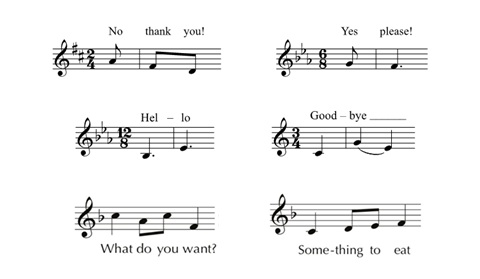
Appendix A: For list of songs used.
To facilitate the learning of the new resources, the participants listened to several iterations of the songs. These were sung initially by the research team, accompanied on a keyboard. As they became familiar with the music, the participants were encouraged to join in. Some of the songs were personalized using the individual names of both participants and the research team and could therefore be repeated for each person in the session. This repetition facilitated the learning. Following each new song, a familiar song was introduced in order to mitigate the memory load. The sessions were led in an informal way, allowing for interaction with each participant. The texts were not visually presented. The Ethos (Ethnographic Observation System) mobile app downloaded to an I Phone was used to video each session. Its link to a web-based project management system, with automatic sorting of video clips, makes it an efficient vehicle for the analysis of the material.
RESULTS
The analysis of the findings was carried out using a quantitative observation schedule based on the Sounds of Intent framework [17] (a measurement of reactive, proactive and interactive musical engagement) and measured engagement both in the moment and over a longer period .Weekly observations by the research team elicited qualitative data analyzed by both authors, relating both to group and individual responses.
The aim of the initial ‘warm-up’ phase was to prime musical engagement through listening to and participating in a music session. Weekly observations made by members of the research team indicated that the responses were the same in both locations with all the participants demonstrating some response to the music. Almost all of them joined in the singing at some point with the majority being able to recall the words. Other physical responses included foot or hand tapping to the beat, clapping and, for the more physically able, dancing. Besides these more obvious signs of response, there was a general increase in attention and communication both with the research team and each other. This, along with the smiling and laughter observed in many, suggests a momentary increase in wellbeing.
Over the six-month period of the study, the attendance of each participant in the intervention phase ranged from five to thirteen sessions. Attendance at the sessions, due to illness or other reasons, was unavoidable given the health needs of this population and a gap of one or two weeks was common. In addition, the research team observed academic terms resulting in one interruption of eight weeks. The participants had no exposure to the musical materials during these intervals.
However, despite absences, they were all able to make some progress in learning the songs. There were some instances where the participants were able to recall the melody and text during the course of one session. Other participants took longer. However, whatever the time taken, once learned, it appeared that the memory trace was robust with delayed recall intact during the subsequent sessions, whether after a gap of one week or as much as eight weeks later (Appendix B).
The first song introduced to the residents was based on the simple greeting, Hello. The average time taken to sing a complete version of this song unprompted in Care Home One was 2.5 sessions, with a range of between one and six sessions; in Care Home Two, it was 3.75 sessions, with a range of between one and nine sessions.
Six case studies, three from each care home, served to provide a more detailed picture of individual learning of the song. No clinical information regarding their diagnosis was available, but observations of the participants’ behavior indicated that three were experiencing symptoms of severe dementia and three of moderate dementia. The results, as shown in the charts below, demonstrate scores for the best performance of each session. The first three, A, D and L (one male, two female) were in the same care home whilst the second three, M, C and V (three female) were in the other. Case studies M and C showed an extraordinary facility with the song, learning it at the first session and recalling it accurately throughout the research period. Their results did not change throughout the research period and their scores are therefore not included in the analysis.
Case Study A was, according to the staff at her care home, the most severely affected of their residents. She had little ability to comprehend language or to communicate. Such speech as she had was more often in Swedish, her mother tongue, and rarely in English. It was therefore difficult for her to interact with staff or residents and she was socially isolated. Her ability to recognize and name people and objects was also impaired, as was her comprehension of time and place (Figure 1).
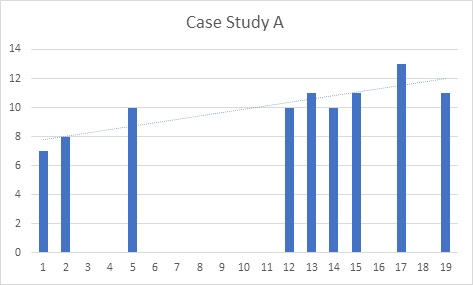
Figure 1: Results of Case Study A.
Despite Case Study A’s lack of ability to communicate, she was able to respond to, and participate in the music. She progressed from mouthing and humming the words in the first session to attempting the complete song on her eighth session. Despite the seven-week gap, as illustrated in the chart, she retained her previous knowledge of the song and was able to sing the first phrase with confidence.
Case Study D’s principal presenting symptoms were high levels of anxiety, agitation and confusion which led to very challenging behavior. He was able to comprehend basic language and to communicate his needs but had little social interaction with those around him. He was unable to recognize or name care staff or fellow residents and had no concept of time or place (Appendix C).
Despite these symptoms, Case Study D was able to learn the song with little difficulty. He progressed quickly from singing the first phrase in week one to completing the song by week four. The singing gave him temporary relief from the continual confusion and agitation that were characteristic of his behavior (Figure 2).
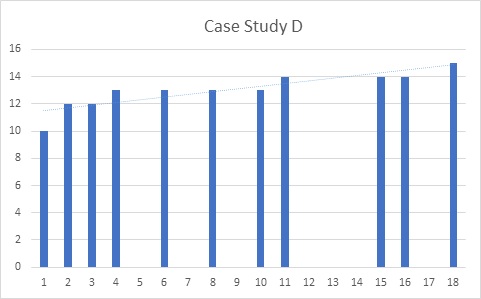
Figure 2: Results of Case Study D.
Case Study L’s primary presenting symptoms were increasing physical frailty, a lack of mobility and deterioration in speech. The latter was affected both by an increasing weakness of the voice and also the ability to access and form words. Despite these limitations, she was able to engage well during the music sessions. From the first week, she attempted to sing the complete song and by the fifth session she was able to sing it fluently. In subsequent weeks she had no difficulty in recalling it, even after a seven-week gap. Although her voice faded over the weeks, her ability to sing the song, albeit very faintly, remained (Figure 3).
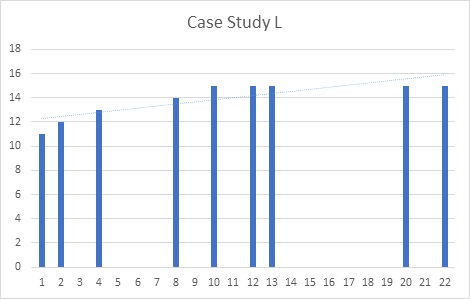
Figure 3: Results of Case study L.
Case Study M displayed less severe symptoms than A, D or L. She was able to understand and respond to simple conversation but made little or no interaction with other residents and had little or no understanding of time or place. She was sometimes very withdrawn. She engaged with the music and from the beginning, was able to join in with some success. Again, even after a fifteen-week gap, she was able to recall the song at the same level of ability. Unfortunately, on three occasions she was not included in the video and there are therefore some sessions without data (Figure 4).
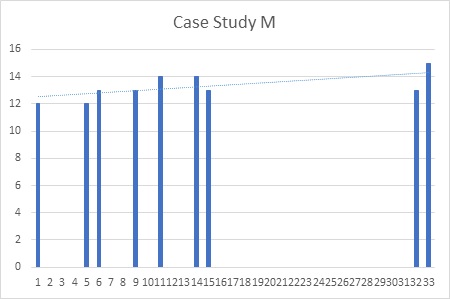
Figure 4: Results of Case study M.
The combined results for the four case studies are shown below (Figure 5).
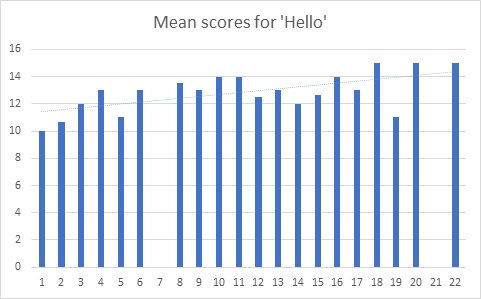
Figure 5: Mean Scores for the ‘Hello’ song.
The ‘Hello’ song, with its simple and repetitive lyrics proved to be the most straightforward of the songs to learn. Songs with more complex texts took longer, for example, the song ‘Who’s sitting next to me?’ The lyrics contained more complex content, had no repetition and required interaction with others. Despite the increased complexity, the participants were able both to learn, retain and recall both music and lyrics, despite significant time lapses, although the time taken to sing unprompted was longer.
Results from the same six case studies were analyzed with the exception of Case Study A whose attendance was insufficient at the relevant sessions. Case studies C and V were included as their scores showed greater variation, thus illustrating the greater challenge of learning this song.
Case study C was able to make everyday conversation and appeared in good health. However, she had no understanding of time or place neither could she recall recent events, even from minutes before. For example, she did not recognize when a song had already been sung in the session. She also had difficulty in recognizing everyday objects and was unable to identify or name care staff or fellow residents. Case study V demonstrated similar symptoms. For example, she was ‘sure’ that she had never met a fellow resident who took part in the sessions week by week.
The combined results of the five case studies for this song are shown in the table below. It demonstrates that both initial and final scores were lower than those for ‘Hello’, but that the ability to sing the song unprompted was attained (Figure 6).
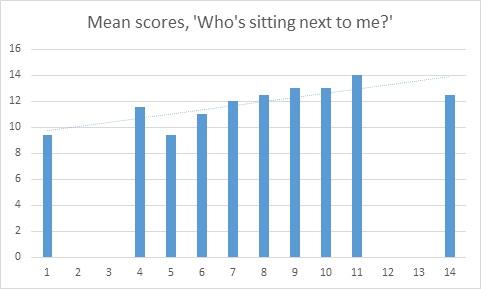
Figure 6: Mean scores for the song, ‘Who’s sitting next to me?’
Other songs presented different challenges. For example, a song set to ‘Good-bye’ was introduced to conclude each session. Although the lyrics were repeated, the last phrase, ‘We’ll see you next ____ (appropriate day) and so until then’, with its requirement of some temporal understanding and flexibility, was challenging for all of them. With the exception of this line, all participants were able to learn the song with ease.
In addition to the time taken to learn, recall and retain the songs, observations elicited further findings. Related to the learning process was the inability of all participants to recall a song by title alone; the first notes of the accompaniment were a necessary prompt for the recall of the songs. In addition, tempo was a factor in facilitating the learning process; slower tempi enhanced the long-term learning. There were other observations related to enhanced wellbeing. First the inclusion of each person’s name in some of the songs (eg ‘Hello’ and ‘Who’s sitting next to me?’) facilitated both eye contact and touch with their co-residents and the research team, thus facilitating some social interaction. Second, their ability to learn, recall and retain a new song gave momentary feelings of achievement and self-confidence, as well as improved access to words that, in some cases, were no longer part of their day-to-day vocabulary. These wider effects, even if short-term, nurtured a sense of wellbeing which was expressed through laughter and smiling. Each participant responded positively and with obvious enjoyment. Initial concerns that the resources, being originally conceived and created for children, might be perceived as patronising, were not justified (Figure 7).
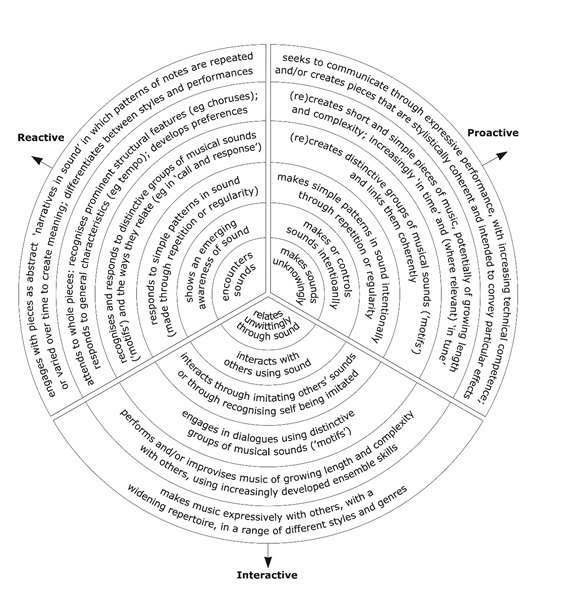
Figure 7: Sounds of Intent Framework.
These results demonstrate the ability of each of the participants, whatever the severity of their cognitive impairment, to learn new musical material. The ability to remember and recall the songs did not appear to relate to the severity of the symptoms.
DISCUSSION
As far as the research team knows, the approach used in this study of using specially composed musical material with texts that are relevant and potentially useful to the everyday lives of the participants is unique. The exploratory nature of this pilot study precludes any definitive statements regarding the outcomes. However, the findings suggest that there is some potential in using a mnemonic strategy to facilitate the recall and use of verbal information in people with dementia. Further research on a larger scale is necessary before any conclusions can be made. However, if found to be effective, this strategy would improve the quality of life, both of people with dementia and their carers.
Some of the findings replicate those of previous research studies. These include the physical responses to the music such as hand and foot-tapping and dancing [18], the increase in wellbeing inferred from smiling, greater alertness and attentiveness [19], improved communication following music sessions [20] and the learning of new music [18-20].
The method of presentation of both melody and text is important to the success of any mnemonic strategy. For the former, the properties of familiarity, valence and structure are all known to be relevant to the outcome; a further variable to be considered is the use of accompaniment. In previous studies, as discussed above, both melodic familiarity, simplicity of structure and, to a certain extent, positive valence, were found to be advantageous. In this study, although it is not possible to make firm conclusions without a comparison of the different approaches, the use of a simple structure and positive valence appeared to enhance recall. This may have been enhanced by the use of an accompaniment. It is interesting to note that both Palisson et al. [12] Ratovohery et al. [14] presented their materials with accompaniment and in both cases, their findings supported the use of mnemonic strategy. In this study, the accompaniment had an important role as a cue to each song’s textual content. Familiar melodies have been beneficial to some previous studies although the results have varied, largely depending on the number of times the materials were presented. In this study, the melodies were specially composed to support the simple texts and, although not familiar, it can be argued that the use of repetition over a period of weeks rendered the new melodies familiar.
In previous studies, the content of the texts has varied in its relevance to the participants and little information is provided as to their content. Moussard et al. [13] suggest that recall would be improved if the texts used were related to the everyday needs and activities of the participants. This was the approach taken in this study. The texts, each very simple in content, were relevant to the participant’s lives, and have potential as a tool for navigating daily life.
Earlier studies cite the initial cognitive load of learning sung as well as verbal material as being a barrier to the success of a mnemonic strategy. However, the use of a repeated learning strategy demonstrated that initial difficulties in learning resources with words and music were not a predictor of the final memory outcome [11,13]. As shown in this study, the style and method of presentation is crucial to the outcome. Repeated presentations of the texts set to simple melodies with accompaniment were, in the majority of cases, easily learnt and subsequently recalled. Importantly, the robustness of the delayed recall of the songs over several weeks demonstrates that once learnt, the songs were firmly embedded in the participants’ memories.
People with dementia within the care home population are unlikely to be in the earlier stages of the disease. By carrying out research in this environment, it was possible to explore the potential of this strategy to a wider dementia population, in particular to those with more severe symptoms. These findings suggest that a mnemonic strategy, using suitable music and texts relevant to the population, is not limited to those with mild symptoms; those with severe symptoms are also able to remember and recall verbal information presented in this way. In addition, this ability encompasses both musicians and non-musicians [3].
Both the informal approach taken in this study and the extended six-month research period made it possible for detailed observations to be made of each participant’s responses to the intervention. However, it was not possible to determine whether there are particular individuals who are most likely to benefit from an intervention of this kind. Cognitive status was not a determinant of the ability to learn and recall the songs, but there may be other factors, such as musical training, which may enhance recall. The findings of previous studies are inconclusive on the relevance of musical training. in a comparison of musicians and non-musicians with AD, found that the musicians had a clear memory advantage. However, Ratovohery et al. [14] suggested that this was unimportant and that a mnemonic strategy can be applied to people with AD irrespective of their musical background.
Given the exploratory nature of this study, there are some methodological limitations which reduce the strength of the findings. First, the lack of a comparison group, as used in the majority of previous studies [2,9,12,13,15]. Without a comparison of the participants’ ability to recall verbal material both with and without melody, it is not possible to make firm conclusions about the superiority of one modality or the other. Second, the lack of demographic information, particularly relating to the dementia diagnosis, makes it impossible to make any conclusions as to the intervention’s relevance to all forms of dementia. Neither care home was able to provide the information and the participants were unable to provide it themselves. Third the size of the sample, This has been a limitation of previous studies, as discussed in the introduction, and is difficult to resolve in this population. Although positive, it is not possible to generalize the findings to the wider dementia population.
There is no definitive explanation for the success of mnemonic strategies in people with dementia. A number of theories have been proposed. First, that the proximity between music and language networks in the brain enhances connections between lyrics and melody [9]. In other words, music combined with words can be recalled at the same time as they are stored together in the brain [13]. Second, that the emotional content of the musical excerpts with their arousing effect may enhance the encoding and consolidation in memory [20]. Third, that the characteristics of the music itself may have an effect. For example, the rhythm of the music can both act as a prompt for the lyrics and limit the choice of words that can be set to the melody. Besides rhythm, the melodic structure can also facilitate memory by attaching units of verbal information to each melodic phrase. Known as chunking, this can reduce memory load.
There are many opportunities for future research arising from this study. Most important to the dementia population, is the need for a study to test the application of these resources in daily life; to test whether, for example, in addition to the ability to recall the sung resources, people with dementia can use them in their daily lives to express simple preferences (say, for particular foods, drinks or activities) and thus allow them greater autonomy over some of their basic needs. Although there is currently no cure for dementia, an intervention that could improve verbal communication for a longer period than would normally be the case in the course of the disease, could enhance the quality of life of both patients and careers. A further benefit of this approach is both its relatively low cost [14] and the near universal enjoyment and capacity for music even for those in the more advanced stages of dementia. Music seems to have the ability to reach the parts of the brain that other interventions cannot, and it has a power beyond its notes to rekindle memories, words and a sense of well-being.
REFERENCES
- Egan M, Bérubé D, Racine G, Leonard C, Rochon E (2010) Methods to enhance verbal communication between individuals with Alzheimer's disease and their formal and informal caregivers: A systematic review. International Journal of Alzheimer’s Disease 2010.
- Baird A, Samson S, Miller L, Chalmers K (2017) Does music training facilitate the mnemonic effect of song? An exploration of musicians and nonmusicians with and without Alzheimer’s dementia. Journal of clinical and experimental neuropsychology 39: 9-21.
- Baird A, Thompson WF (2018) The impact of music on the self in dementia. Journal of Alzheimer's Disease 61: 827-841.
- Schön D, Morillon B (2019) Music and Language. In Thaut MH, Hodges DA (Eds.) The Oxford Handbook of Music and the Brain. (pp. 391-418). Oxford University Press.
- Carozza, Serrone, Sugatan (2017) Non-pharmacological approaches in dementia. Music and Medicine 4: 253-261.
- Hubbard G, Cook A, Tester S, Downs M (2002) Beyond words: Older people with dementia using and interpreting nonverbal behaviour. Journal of Aging Studies 16: 155-167.
- Kerer M, Marksteiner J, Hinterhuber H, Mazzola G, Kemmler G, et al. (2013) Explicit (semantic) memory for music in patients with mild cognitive impairment and early-stage Alzheimer's disease. Experimental Aging Research 39: 536-564.
- Simmons Stern NR, Budson AE, Ally BA (2010) Music as a memory enhancer in patients with Alzheimer's disease. Neuropsychologia 48: 3164-3167.
- Stern NRS, Deason RG, Brandler BJ, Frustace BS, O'Connor MK, et al. (2012) Music-based memory enhancement in Alzheimer's disease: Promise and limitations. Neuropsychologia 50: 3295-3303.
- Webb PP, Speelman CP (2008) Effects of music on memory for text. Perceptual and Motor Skills 106: 927-957.
- Moussard A, Bigand E, Belleville S, Peretz I (2012) Music as an aid to learn new verbal information in Alzheimer's disease. Music Perception: An Interdisciplinary Journal 29: 521-531.
- Palisson J, Roussel-Baclet C, Maillet D, Belin C, Ankri J, et al. (2015) Music enhances verbal episodic memory in Alzheimer’s disease. Journal of clinical and experimental neuropsychology 37: 503-517.
- Moussard A, Bigand E, Belleville S, Peretz I (2014) Learning sung lyrics aids retention in normal ageing and Alzheimer's disease. Neuropsychological Rehabilitation 24: 894-917.
- Ratovohery S, Baudouin A, Palisson J, Maillet D, Bailon O, et al. (2019) Music as a mnemonic strategy to mitigate verbal episodic memory in Alzheimer’s disease: Does musical valence matter? Journal of Clinical and Experimental Neuropsychology 41: 1060-1073.
- Ockelford A, Atkinson R (2019) ‘Music education and music in education’, (in) von Tetzchner S Elmerskog B, Tøssebro A, Rokne S (eds), Juvenile Neuronal Ceroid Lipofuscinosis, Childhood Dementia and Education, Melhu, Norway: Snøfugl Forlag 343-358.
- Ockelford A (2012) ‘Songs without words: Exploring how music can serve as a proxy language in social interaction with autistic children’, (in) Music, Health, and Wellbeing, MacDonald R, Kreutz G, Mitchell L (eds), New York, NY: Oxford University Press 289-323.
- Ockelford A (2013) Applied musicology: Using zygonic theory to inform music education, therapy, and psychology research. Oxford University Press.
- Cuddy LL, Duffin J (2005) Music, memory, and Alzheimer’s disease: Is music recognition spared in dementia, and how can it be assessed? Medical Hypotheses 64: 229-235.
- Hsu MH, Flowerdew R, Parker M, Fachner J, Odell-Miller H (2015) Individual music therapy for managing neuropsychiatric symptoms for people with dementia and their carers: A cluster randomised controlled feasibility study. BMC Geriatrics 15: 84.
- Hammar LM, Emami A, Götell E, Engström G (2011) The impact of caregivers’ singing on expressions of emotion and resistance during morning care situations in persons with dementia: An intervention in dementia care. Journal of clinical nursing 20: 969-978.
APPENDIX A
Examples of Songs used in weekly music sessions.
Daisy, daisy, give me your answer do. Lyrics and music by Harry Dacre
Somewhere Over the Rainbow. Lyrics and music by Israel Kamakawiwo’ole.
When the Red Red Robin. Lyrics and music by Harry Woods.
Que Sera, Sera. Lyrics by Ray Evans, music by Jay Livingston.
It’s a long way to Tipperary. By Henry James ‘Harry’ Williams and co-credited to Jack Judge.
Moon River. Lyrics by Johnny Mercer, music by Henry Mancini.
Tea for Two. Lyrics by Irving Caesar, music by Vincent Youmans.
Pack up your troubles in your old Kit-Bag. Lyrics by George Henry Powell, music by Felix Powell.
We’ll meet again. Lyrics and music by Ross Parker and Hughie Charles.
You are my sunshine. Lyrics and music by Jimmie Davis and Charles Mitchell.
Sweet Molly Malone. A traditional Irish song.
My bonnie lies over the ocean. A traditional Scottish song.
Loch Lomond. A traditional Scottish song.
I’m forever blowing bubbles. Lyrics by Jaan Kenbrovin, music by John Kellette.
Bye Bye blackbird. Lyrics by Mort Dixon, music by Ray Henderson.
Auld Lang Syne. Lyrics by Robert Burns, set to a traditional folk song.
Danny Boy. Lyrics by Frederic Weatherly, set to a traditional Irish folk song, Londonderry Air.
My Old Man’s a Dustman. Lyrics and music by Lonnie Donegan.
A nightingale sang in Berkeley Square. Lyrics by Eric Maschwitz, music by Manning Sherwin.
Edelweiss. Lyrics by Oscar Hammerstein, Music by Richard Rogers.
I’m Singing in the Rain. Lyrics and music by Gene Kelly.
APPENDIX B
The Observation Schedule used to assess learning of the songs is based on the Sounds of Intent framework shown on Page 17. Scores were given according to the Interactive Domain:
- No apparent engagement-level 1
- Engagement through a response (emotional) – smiling, crying or indeterminate eg some vocalisation. Level 2
- Engagement through entrainment eg clapping, tapping, nodding. Level 3
- Join in the main motif of the song with prompts. Level 4
- Able to sing complete song with accompaniment. Level 5
APPENDIX C
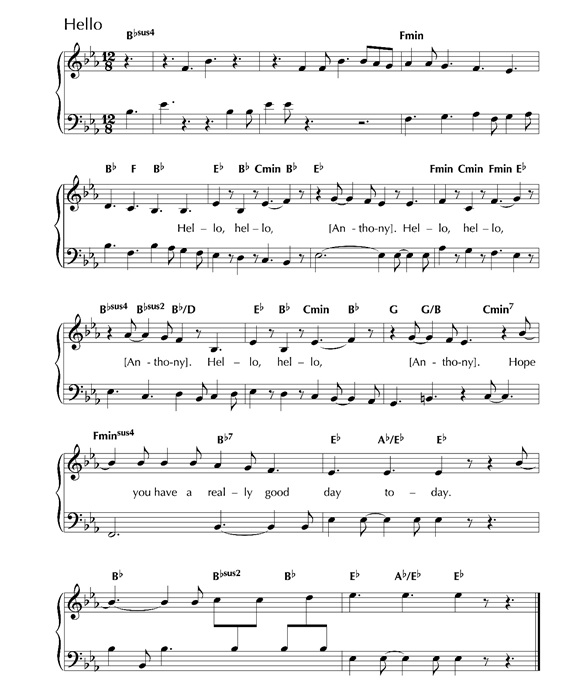
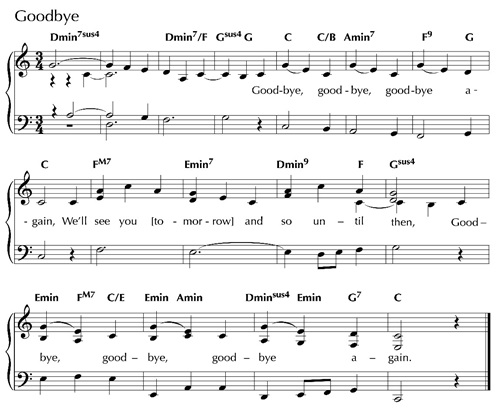
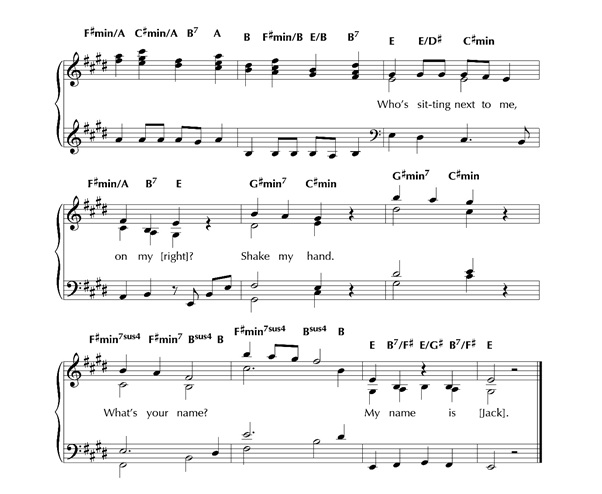
Citation: Costa F, Ockelford A, Shaughnessy C (2020) A Report of a Pilot Study Exploring the use of a Mnemonic Strategy for the Recall and use of Functional Language in People with Dementia. J Alzheimers Neurodegener Dis 6: 042.
Copyright: © 2020 Fiona Costa, et al. This is an open-access article distributed under the terms of the Creative Commons Attribution License, which permits unrestricted use, distribution, and reproduction in any medium, provided the original author and source are credited.

